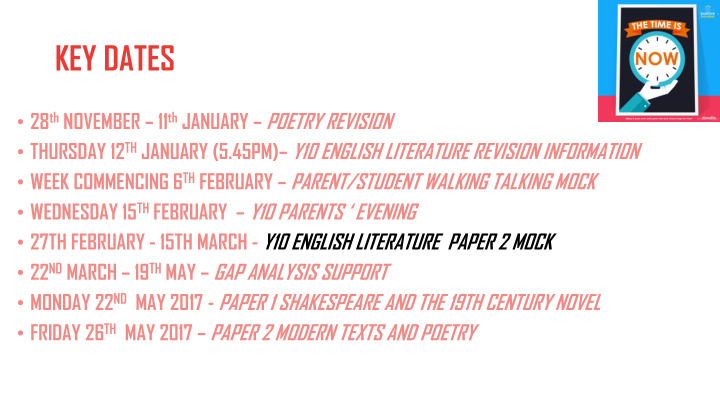



KEY DATES • 28 th NOVEMBER – 11 th JANUARY – POETRY REVISION • THURSDAY 12 TH JANUARY (5.45PM) – Y10 ENGLISH LITERATURE REVISION INFORMATION • WEEK COMMENCING 6 TH FEBRUARY – PARENT/STUDENT WALKING TALKING MOCK • WEDNESDAY 15 TH FEBRUARY – Y10 PARENTS ‘ EVENING • 27TH FEBRUARY - 15TH MARCH - Y10 ENGLISH LITERATURE PAPER 2 MOCK • 22 ND MARCH – 19 TH MAY – GAP ANALYSIS SUPPORT • MONDAY 22 ND MAY 2017 - PAPER 1 SHAKESPEARE AND THE 19TH CENTURY NOVEL • FRIDAY 26 TH MAY 2017 – PAPER 2 MODERN TEXTS AND POETRY
How can you support your child with planning a response to an exam question on Romeo and Juliet? • Your child should spend 45 minutes on this question in the exam. Starting with the extract, explain how Shakespeare presents conflict in the play. (30 marks + 4marks for SPaG) Write about: 5 minutes planning • How Shakespeare presents conflict in the extract. 40 minutes writing • How Shakespeare presents conflict throughout the play. Students should aim to write between 4-5 detailed paragraphs. • At least three paragraphs should be about where we see the theme of conflict in the extract only. Students should analyse the language in detail and explain the language techniques Shakespeare has used.
How can you support your child with planning a response to an exam question on Romeo and Juliet? • Identify the key scenes where we see the theme of conflict. Students should aim to refer to at least two other parts of the play. • Act 1 scene 1: The play begins with the conflict between the Montagues and Capulets. • Act 3 scene 5: We see the conflict between a father and daughter. When Juliet refuses to follow her father’s orders, he becomes very aggressive and violent. • Act 5 scene 3: We see the catastrophic results of the ongoing conflict between the Montagues and Capulets. Romeo and Juliet take their own lives.
How can you support your child with planning a response to an exam question on Romeo and Juliet? • Step 2: Explain how we see this theme. Who is the conflict between? How does Shakespeare show the conflict to the audience?
Example of a plan Conflict • Act 1 scene 1:Conflict introduced at the beginning . Immediate - hatred between the two rival families. • Audience aware of rivalry, Montagues and Capulets use insulting language: “Do you bite your thumb at us sir?” • Shakespeare emphasises hatred and conflict - Tybalt’s character: “I hate hell, all Montagues and thee.” • Act 3 scene 5: Conflict between father and daughter - Juliet refuses to follow her father’s orders. • He refers to her as “baggage” and “a disobedient wretch” • Shakespeare emphasises conflict through Lord Capulet’s he controls and threatens his daughter. She will “die in the streets” • Link to context: during the Elizabethan period, men had complete control and authority over women. It was considered “normal” for your father to select your husband.
On-going Revision • Your child will need plans/cue cards for the following themes: Love Hate Conflict Fate Parent and child relationships
Checklist for Parents • Your child’s plans need to include: Key scenes where we see the theme. The characters involved with the theme. What happens in the scene and how the writer shows this theme to the audience. Key quotes which link to the theme. Link to context. This is the same for the novel and An Inspector Calls.
Revising the anthology poems • English Literature Paper 2 Section B • Compare one named poem from the anthology with a poem of your choice. • Students will have a copy of the named poem in the exam. 5 minutes planning 40 minutes writing
Recommend
More recommend